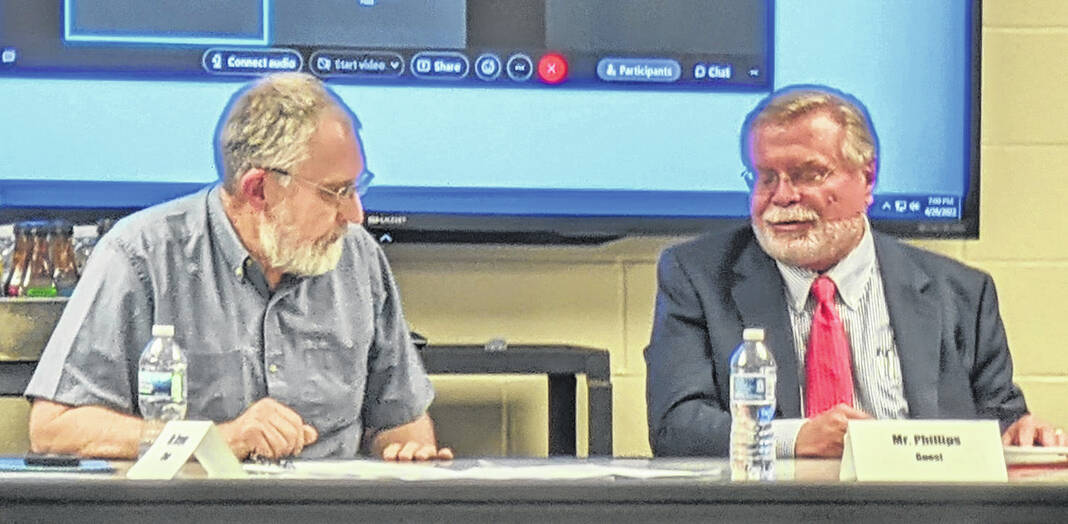MOUNT GILEAD — Cleveland Attorney Michael D. Phillips spoke to the Morrow County Hospital Board’s Request for Proposal (RFP) Committee last week in a meeting focused on the possibility of converting the hospital to a 501(c)(3) or non-profit entity.
The RFP Committee is made up of members of the Hospital Board and Commissioner Tim Siegfried. The RFP meeting was held prior to the regular monthly board meeting.
Phillips said he has practiced law 45 years, primarily in healthcare work for hospitals of all types and sizes, including MetroHealth.
In early April hospital board members Joe Dreyer and Jennifer Williams contacted Phillips about speaking with the RFP committee concerning details of converting to a non-profit. Williams said they contacted him because of community discussion about the 501(c)(3) option. Two other Columbus attorneys declined because of conflicts of interest with OhioHealth.
Phillips asked questions for the committee to consider: what is the ability of the hospital to survive as a stand-alone hospital? What is the financial ability to fund the physical plant and what is the level of competition in the area?
He noted that of 24 or 25 county hospitals in Ohio when he began working on healthcare, only four or five are still in existence.
Details of conversion to non-profit
This type of conversion is a common one for hospitals. Phillips said for many of the hospitals which converted to a non-profit, the non-profit entity was most often a bridge to another step, such as a merger with a larger health system.
“Conversions are often done to facilitate the next step,” Phillips said. As a non-profit, it can enter an affiliation or change in control and another entity can assume control.”
One example he gave is Robinson Memorial Hospital in Portage County. It converted to a non-profit and then was put up for sale through an RFP process. It then became a member of University Hospital in Cleveland.
“Conversions sound simple, but there are many things to be considered,” Phillips said, adding there is no checklist to follow for conversions because there are different factors in each situation. “You’ve seen one situation, you’ve seen one situation.”
Asked how a conversion would work, he said some or all of the hospital’s assets are transferred to a non-profit entity.
Philips emphasized it’s important to look at “what you are up against.”
It is vital to consider current status financially, local issues of competition, growth of the region and whether the hospital can stand alone.
“It’s important to decide where you want to go, what do you gain, or give up?” Phillips said.
Steps in converting to non-profit status
The first issue to be resolved is to be clear on the non-profit’s purpose, Phillips said.
Dr. Vincent Trago asked if the hospital could use the physicians’ previous practices entity, Morrow County Health Services, and transfer the property and assets to it.
Phillips said it is cleaner and simpler to start with a new entity. There may be some unknown history, liability or complication with a previous entity.
After deciding on what direction to take, the next big question is how to handle the real-estate.
The property can be leased from the county to the non-profit; it can be given to the non-profit or sold to the new non-profit, Phillips said.
Phillips said many counties don’t want to walk away from their hospital. Often there are clauses that the hospital returns to the county if the non-profit ceases to exist. Counties want to make sure the county continues with good healthcare to protect peoples’ best interest.
Whether to keep a levy is also a local issue that needs to be addressed.
Another important issue is how employees who are Ohio Public Employees Retirement System (OPERS) members are compensated.
There ways to deal with those employees who are vested and stay and also look at how a new entity would handle retirement.
Some questions answered
RFP member Williams said it seems the conversion to a 501(c)(3) isn’t a final solution. There is still a lot of work to make sure the hospital will thrive.
Phillips agreed the non-profit conversion is just a step for most. He had experience with only a couple of larger hospitals where a conversion worked for a long time.
Committee members said they heard that Morrow County looked at the possibility of converting to non-profit 10 years ago.
Past hospital board member Pat Anthony spoke up to say the board did look at the non-profit option and decided it wasn’t feasible at that time.
Dreyer asked Phillips about the pros and cons of this option for Morrow County.
Phillips said, “It looks like you are in a difficult situation with lots of surrounding competition.”
“Once you’ve fastened on to what you want for the future, you can look at what means – whether partnership or another avenue is best.”
Phillips said it’s a difficult time for small hospitals if they don’t have the support of a larger system.
He said there will likely be more change for healthcare in the next five years in insurance, Medicaid and Medicare, the economy and technical advances.






